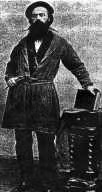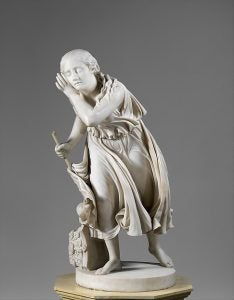“Athens of the Midwest”
The idea of Ann Arbor as the “Athens of the Midwest” emerged at least as early as the 1850s, if not earlier, with the move of the University from Detroit in 1837.
Henry P. Tappan, Professor of Philosophy and first President of the University of Michigan (1852-1863), envisioned a great university that would make Ann Arbor “a new Athens.” He was very important to the University of Michigan in its early years as he was determined to create a university where professors did original research, used lectures to teach, and trained graduate students (Marwil 1991: 28). He was a very authoritative figure and instilled a new purpose into the institution, its faculty, and students. In his inaugural address he stated that “there is no question of the classics” and that a new Athens shall arise with its schools of Philosophy and Art, and its Acropolis crowned with another Parthenon, more glorious than that of old” (lib.umich.edu).
He may have been influenced by descriptions, first of Philadelphia (1790s-1800s) and later of Boston (1820s-40s), as the “Athens of America.” He must have been certainly influenced by the well-known association of the University since its creation (1817) with Greek wisdom and learning.
In 1852, the year President Tappan delivered his inaugural address which concluded with the impassioned call for “a new Athens,” he also published a study which discussed various European countries in a search for the ideal city. His view of Athens further explains why he wanted to model Ann Arbor on the ancient city: “If we are to gather ideas from any, let us rather go back to democratic Athens, where the spirit of a free people breathed through forms of art so cheerful and beautiful that even now, when we gaze upon the ruins, we gain inspirations that make our free hearts leap within us” (Tappan A 1852a: 59). Tappan believed in the value of an classical education and sought to re-create an educational environment similar to Classical Athens, where many great intellectuals lived and spread their teachings to those who would listen. Additionally, by creating a new and improved Parthenon he wanted to make the University of Michigan a school that was the best of the best and model for others to follow:
“The city of Athens—the city itself was the home of every Athenian. The city was his pride and glory. And why was it? Because, there was the Acropolis with its temples, and the whole city was adorned by the hands of its artists. There was the grove of Academus. There was its theatre—not like our theatres, places for the exhibition of buffooneries and farces, but a vast place, open to the heavens, where the whole population assembled to hear the compositions of Aeschylus, Euripides and Sophocles. There was the Areopagus. There were the assemblies of the people where Aeschines and Demosthenes reasoned and thundered—in no barbaric vulgar style—but in pure classic Greek, with cultivated oratory, before a people who were competent judges of eloquence and grace. Athens had commerce and arms, merchants and heroes; but it was philosophy, poetry, eloquence and art which so polished and enriched it, and invested it with such splendid attractions and dear associations, that it was the only home in the wide world that an Athenian could find” (Tappan A 1852a: 209).














